Transwede Airways
Transwede Airways AB, doing business as Transwede, was a Swedish charter and later also scheduled airline operating between 1985 and 1998. Based at Stockholm Arlanda Airport, Transwede initially flew Sud Aviation Caravelles and from 1987 also McDonnell Douglas MD-80s. Most charter services were inclusive tour flights to the Mediterranean.
 | |||||||
| |||||||
| Founded | 1 April 1985 | ||||||
|---|---|---|---|---|---|---|---|
| Ceased operations | 1 January 1998 | ||||||
| Operating bases | Stockholm Arlanda Airport | ||||||
| Fleet size | 7 (1997) | ||||||
| Destinations | 7 (1998) | ||||||
| Headquarters | Sigtuna Municipality, Sweden | ||||||
The first scheduled services were from Stockholm to London in 1991. After the Swedish domestic market was deregulated the following year, Transwede variously started services from Stockholm to Visby, Umeå, Luleå, Sundsvall, Malmö and Halmstad. From 1993 the domestic services were conducted using Fokker 100 aircraft. The airline had about a 13-percent domestic market share in Sweden.
The airline was split up in 1996, following a period of losses. The charter division was sold to Fritidsresor, who renamed the airline Blue Scandinavia. Via a series of purchases this has since 2006 been called TUIfly Nordic. The scheduled division was bought by Norwegian carrier Braathens SAFE, who renamed the two airlines Braathens from 1998, integrating Transwede's operations into their own.
History
Establishment and early years
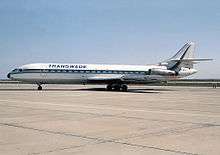
Transwede was founded on 1 April 1985[1] in Växjö by Thomas Johansen, who was also the company's first president. He had previously founded regional airline Swedair. Johansen intended to fill the gap created after the last Swedish inclusive tour charter operator, Transair Sweden, ceased operations in 1979. Initially the airline bought two 109-seat Sud Aviation Super Caravelles and was contracted by Royal Tours. The airline moved its main base to Stockholm Arlanda Airport the following year.[2] It bought the tour operator Royal Tours in November 1986 in order to secure access to 200,000 annual charter passengers.[3]
Within a year the airline bought two McDonnell Douglas MD-83 aircraft to supplement its Caravelles.[4] There were among others used from 1987 on a charter service from Stockholm via Oslo, Norway, and Gander, Canada, to Fort Lauderdale in the United States. The 414-kilometer (257 mi) Oslo to Gander leg was the longest MD-80 revenue leg in the world.[5] By 1990 the fleet was substantially increased, adding a Boeing 737-200, two Boeing 737-300s, two MD-87s and bringing the number of MD-83s up to four.[6]
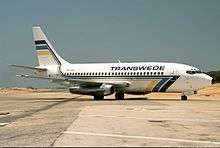
Scheduled operations
At the time Linjeflyg and its parent Scandinavian Airlines System (SAS) controlled virtually all domestic air traffic in Sweden, based on a monopoly granted through a series of government concessions. Transwede started working against this system in 1989, when they applied to operate a direct service from Göteborg Landvetter Airport to Sundsvall Airport and Skellefteå Airport. This would require the airline to buy smaller turboprop aircraft.[7] This did not hinder Linjeflyg and Transwede from cooperating in other areas, with the former wet leasing Caravelles and MD-80s when in need.[8] Transwede also signed an agreement with the Swedish Armed Forces to operate the first domestic charter service in Sweden, twice weekly from Gothenburg to Luleå Airport.[9] They subsequently applied to operate the route as a twice-daily scheduled flight.[10] The airline had a revenue of 800 million kronor in 1989, but failed to make a profit. Chairman Lars Svenheim replaced Thomas Johansson as CEO in May 1990.[11]
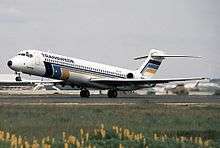
Transwede applied in June 1990 to operate a scheduled service from Stockholm, Gothenburg and Malmö to London Gatwick Airport.[12] International routes out of Scandinavia had since the 1940s been the domain of Scandinavian Airlines System, but in 1990 the Danish authorities granted domestic carrier Maersk Air the right to start a Gatwick service out of Copenhagen. Transwede used this as leverage to secure itself a similar right out of the Swedish capital. Transwede started the service eight times per week, using a single-class MD-83, offering prices 32 percent below SAS and British Airways.[13]
Meanwhile, Sterling Airways's owner TransNordic Group bought a 33-percent stake in Transwede. They had bought a similar stake in Norway Airlines, who had received concession to operate an Oslo to Gatwick route. In addition to the London routes, the three airlines aimed at starting services on the lucrative "capital triangle" between the three Scandinavian capitals.[14] Within a year Transwede was flying three daily flights to London and had captured a 29-percent market share.[15] The partnership lasted until April 1993.[16]
Transwede's interests shifted in 1992, following the merger between SAS and the main Swedish domestic carrier, Linjeflyg. Due to their concessionary monopolies, the new airline would receive a 97-percent domestic market share. Meanwhile, this opened for deregulation of the domestic air carrier market.[15] The same year Leif Lundin replaced Lars Svenheim as CEO.[17] This only lasted until December, when Lundin was replaced by Christer Petrén.[18]
The airline's first domestic scheduled service commenced on 22 July 1992, between Stockholm and Visby Airport, serving the island of Gotland.[19] This was followed in July with flights from Stockholm to Malmö Airport, on 7 August to Umeå Airport.[20][21] In August Transwede started an interlining cooperation with Finnair, whereby the two coordinated their timetables and fed passengers into each other's networks.[22]
%2C_Transwede_Airways_AN0069456.jpg)
The first scheduled route to be terminated took place in October 1992, with the closing of the Visby route.[23] The other main newcomer on the market, Malmö Aviation, gave up its routes from Malmö to London in early 1993, and Transwede took over the concession from April 1993.[24] It followed up on 9 May with commencing a scheduled service from Halmstad Airport to Stockholm, with three daily round trips.[25] Sundsvall to Stockholm commenced services on 19 September.[26] As the airline regarded the MD-80s as too large for domestic services, they leased five 107-seat Fokker 100s, with an option for two more.[27] The options were effectuated to allow Transwede to start services from Stockholm to Jönköping from 25 March 1994.[28] The two MD-87s were subsequently leased out.[29] In order to avoid another competitor on the Jönköping route, Transwede bought the new entrant Falcon Aviation who planned to start that route as well.[30]
Transwede and SAS signed an interlining agreement in February 1994 to allow through tickets to be bought on multi-legged flights with both airlines.[31] Weeks later Transwede announced a cooperation with Lufthansa, whereby the two would provide similar arrangements for flights between Sweden and Germany.[32] For SAS-executive Lars Bergvall replaced Petrén as CEO in late 1994.[33] By the end of 1994, the airline had captured about 30 percent market share on those routes it flew, with a record 36 percent on the Stockholm to Luleå run.[34] Although revenue increased from 1.2 billion kronor in 1993 to 2.0 billion in 1994, the airline ended with a deficit both years of about 300 million.[35] The most costly route was to Malmö, and the airline thus chose to terminate it from January 1995.[36] Meanwhile, the established a route from Umeå to Gällivare Airport, which the subcontracted to Air Nordic using a Fokker F-27.[37]
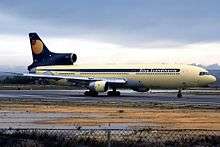
Splitting up
While the airline succeeded at a near break-even on scheduled services, it saw huge losses in the charter market, largely driven by overcapacity in the market. For instance, Transwede lost 100 million kronor in the first five months of 1995. This followed a fleet downsizing that year reducing the airline's charter division to five MD-83s and two MD-87s. Jan Carlzon was hired as chairman in early 1995, and immediately set about to reorganize the airline. It was divided into three business units, which became separate companies. Ownership of the charter division passed to Nordpool, a grouping of inclusive tour operators. The remainder of Transwede was partially bought by Nordic Capital.[38]
Ownership of the charter division, initially named Transwede Leisure, soon passed to the major Swedish tour operator Fritidsresor. The charter airline was subsequently renamed Blue Scandianvia. It was bought by Thomson Travel Group and has since been transformed into TUIfly Nordic.[39]
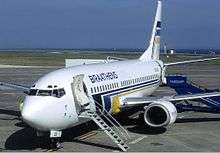
Braathens SAFE, the largest domestic carrier in Norway, entered negotiations in 1996 to purchase Transwede from its owners, Transpool.[40] The purchase of Transwede was confirmed on 25 June;[41] Braathens SAFE bought 50% of the company's scheduled division, Transwede Airways, with an option to purchase the rest in 1997. The companies planned to integrate their networks, to allow connection between Braathens SAFE's and Transwede flights at Stockholm.[42] Braathens SAFE started flights from their main hub at Oslo Airport, Fornebu to Stockholm on 6 November [43] After three months, the airline had captured 14% of the Oslo–Stockholm market.[44] SAS operated fifteen flights per day, while Braathens only had seven on a route which was regarded as one of SAS' most profitable.[45]
Transwede started replacing its Fokker 100s with Boeing 737-300 in 1997.[46] Braathens SAFE was criticized by the Norwegian Airline Pilots Association because it was using retired Braathens SAFE pilots to fly Transwede aircraft, due to Transwede not having certified pilots for their new Boeing 737-300. Braathens SAFE stated that this was within the rules of the Swedish Civil Aviation Administration and the Joint Aviation Authorities.[47]
Braathens SAFE bought the remaining half of Transwede on 18 December 1997, paying 2 kronor. In addition came 13 million in converted debt. With the take-over, the company changed its name to Braathens Sverige AB. At the same time, management announced that they planned to replace all the company's Fokker 100s with 737-300s.[48]
Fleet
| Aircraft | Image | Quantity | Start | End | Ref |
|---|---|---|---|---|---|
| Sud Aviation Caravelle | 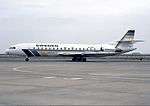 | 3 | 1985 | 1990 | [6][1] |
| McDonnell Douglas MD-83 | %2C_Transwede_Airways_AN0208180.jpg) | 7 | 1986 | 1996 | [1] |
| McDonnell Douglas MD-87 | 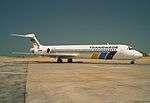 | 2 | 1989 | 1994 | [29] |
| Boeing 737-200 |  | 2 | 1989 | 1990 | [6][49] |
| Boeing 737-300 | 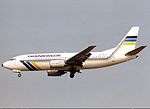 | 1 | 1996 | 1997 | [47] |
| Fokker 100 | 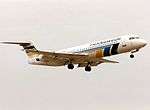 | 7 | 1993 | 1997 | [27] |
Destinations
The following is a list of scheduled destinations served by Transwede.
| Location | Airport | Period | Ref |
|---|---|---|---|
| Gällivare | Gällivare Airport | 1995–96 | [37] |
| Halmstad | Halmstad Airport | 1993–97 | [25] |
| Jönköping | Jönköping Airport | 1994–97 | [28] |
| London | London Gatwick Airport | 1991–97 | [13] |
| Luleå | Luleå Airport | 1993–97 | [34] |
| Malmö | Malmö Airport | 1993 | [24][36] |
| Sundsvall | Sundsvall-Timrå Airport | 1993–97 | [26] |
| Stockholm | Stockholm Arlanda Airport | 1991–97 | [13] |
| Umeå | Umeå Airport | 1993–97 | [20] |
| Visby | Visby Airport | 1993 | [23] |
Accidents and incidents
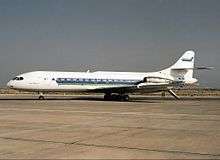
On 6 January 1987 a Sud Aviation SE-210 Caravelle 10R (SE-DEC) crashed at Stockholm Arlanda Airport. Immediately after take-off, at an altitude of 10 meters (33 ft), a fault with the elevator caused the nose to pitch down and the aircraft to land hard. The aircraft subsequently slid off the runway and bust into fire. The aircraft was damaged beyond repair. None of the six crew members and twenty-one passengers were killed.[50][51]
References
- "World Airline Directory". Flight International. 26 March 1988. p. 126.
- "Sweden starts charter again". Flight International. 30 November 1985. p. 2.
- "Charter" (in Swedish). Tidningarnas Telegrambyrå. 27 November 1986.
- "World Airline Directory". Flight International. 26 March 1988. p. 121.
- "News Scan". Flight International. 26 September 1987. p. 121.
- "World Airline Directory". Flight International. 14 March 1990. p. 134.
- "Linjeflyg och Transwede i hård flygstrid" (in Swedish). Tidningarnas Telegrambyrå. 14 February 1989.
- "Luftfartsverket motsätter sig att Linjeflyg hyr in utländska plan" (in Swedish). Tidningarnas Telegrambyrå. 17 February 1989.
- "Första svenska charterlinjen" (in Swedish). Tidningarnas Telegrambyrå. 17 February 1989.
- Theander, Ola (29 March 1989). "Flyg". Västerbottens-Kuriren (in Swedish).
- Montan, Alf (16 May 1990). "Transwedes grundare sparkad från direktörsposten". Expressen (in Swedish).
- "Transwede vill flyga till London" (in Swedish). Tidningarnas Telegrambyrå. 28 June 1990.
- "Seconds out". Flight International. 12 June 1991. p. 124.
- "Scandinavian airline trio united". Flight International. 18 September 1991. p. 18.
- "Transwede plans SAS monopoly fight". Flight International. 18 September 1991. p. 18.
- "Transwede bryter alliansen med Sterling" (in Swedish). Tidningarnas Telegrambyrå. 15 April 1993.
- "Transwede Airways". Flight International. 3 June 1992. p. 36.
- "Ny Transwedechef". Expressen (in Swedish). 5 December 1992.
- Sjöblom, Anita (13 June 1992). "Flyget slåss om Gotland. Linjeflyg och Transwede öppnar skytteltrafik och". Dagens Nyheter (in Swedish).
- "Transwede startar flygningar till Umeå" (in Swedish). Tidningarnas Telegrambyrå. 23 June 1992.
- "Transwede flyger på Göteborg och Umeå" (in Swedish). Tidningarnas Telegrambyrå. 23 July 1992.
- "Transwede startar samarbete med Finnair" (in Swedish). Tidningarnas Telegrambyrå. 11 August 1992.
- Hellberg, Anders (3 April 1993). "Oviss framtid för flyglinje till Gotland". Dagens Nyheter (in Swedish).
- "Transwede övertar Malmö Aviations Londonresor" (in Swedish). Tidningarnas Telegrambyrå. 1 April 1993.
- "Flygkrig i Halmstad" (in Swedish). Tidningarnas Telegrambyrå. 27 April 1993.
- "Transwede börjar flyga på Sundsvall" (in Swedish). Tidningarnas Telegrambyrå. 26 August 1993.
- "Flurry of orders reduces Fokker 100 stockpile". Flight International. 28 July 1993. p. 12.
- "Transwede hyr två nya plan för Jönköpingstrafiken" (in Swedish). Tidningarnas Telegrambyrå. 4 February 1994.
- "Transwede hyr ut två plan" (in Swedish). Tidningarnas Telegrambyrå. 17 February 1994.
- "Transwede öpte ut Falcon Aviation" (in Swedish). Tidningarnas Telegrambyrå. 26 March 1994.
- "SAS och Transwede i biljettssamarbete" (in Swedish). Tidningarnas Telegrambyrå. 18 February 1994.
- "Transwede innleder samarbete med Lufthansa" (in Swedish). Tidningarnas Telegrambyrå. 4 March 1994.
- "Lars Bergvall ny VD i Transwede" (in Swedish). Tidningarnas Telegrambyrå. 24 October 1994.
- Petersson, Torbjörn (25 October 1994). "Uppåt för uppstickare. Transwede och Malmö Aviation tar nya". Dagens Nyheter (in Swedish).
- "Transwedes förluster ökar" (in Swedish). Tidningarnas Telegrambyrå. 23 November 1994.
- "Transwede ger upp attraktiv flyglinje". Göteborgs-Posten (in Swedish). 13 December 1994.
- Rönneberg, Roger (9 February 1995). "Transwede byter till mindre plan". Västerbottens-Kuriren (in Swedish).
- "Transwede is forced into radical change". Flight International. 5 July 1995. p. 9.
- Chuter, Andrew (14 January 1998). "Britannia will rule carrier Blue Scandinavia after take-over". Flight International. p. 12.
- "Ville kjøpe Transwede". Dagens Næringsliv (in Norwegian). 4 June 1996. p. 24.
- "Braathens kjøper Transwede" (in Norwegian). Norwegian News Agency. 25 June 1996.
- Guhnfeldt, Cato (27 June 1996). "Braathens-raid i Sverige". Aftenposten (in Norwegian). p. 3.
- Guhnfeldt, Cato (5 November 1996). "Arbeid & penger notiser". Bergens Tidende (in Norwegian). p. 10.
- Schiefloe, Ingrid (22 February 1997). "Braathens SAFE er byråfavoritten". Dagens Næringsliv (in Norwegian). p. 34.
- Lillesund, Geir (18 June 1996). "Braathens vil konkurrere med SAS på Stockholm-ruten" (in Norwegian). Norwegian News Agency.
- "Nordmenn får svensk selskap på vingene". Aftenposten (in Norwegian). 18 June 1997. p. 35.
- Ulv, Kirsten (22 May 1997). "Pensjonerte Braathens-piloter flyr for Transwede". Dagens Næringsliv (in Norwegian). p. 15.
- Tuv, Kirsten (19 December 1997). "Solgt for to kroner". Dagens Næringsliv (in Norwegian). p. 17.
- "World Airline Directory". Flight International. 1 April 1989. p. 127.
- "Flygbrister" (in Swedish). Tidningarnas Telegrambyrå. 10 February 1987.
- "Tuesday 6 January 1987". Aviation Safety Network.
| Wikimedia Commons has media related to Transwede. |